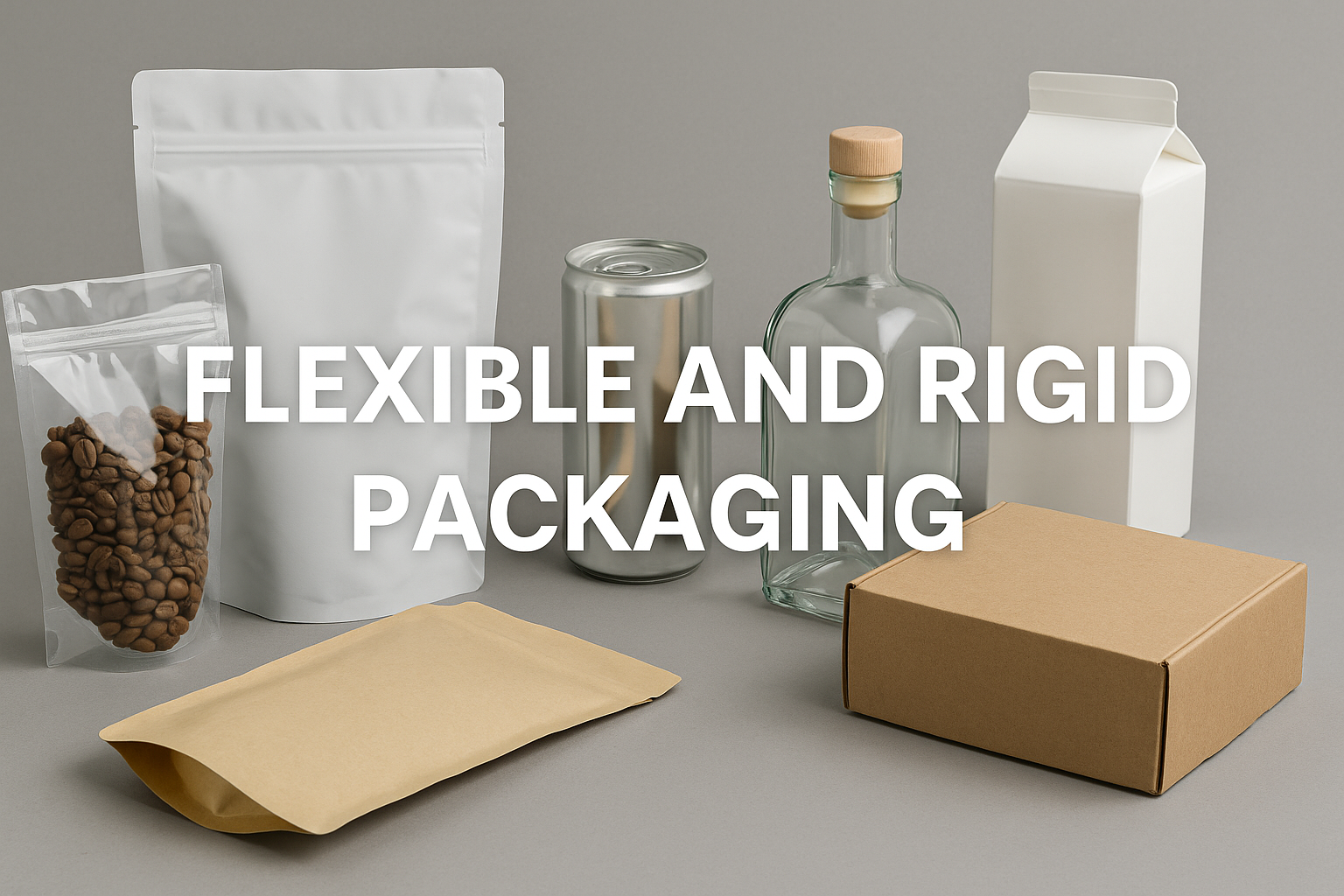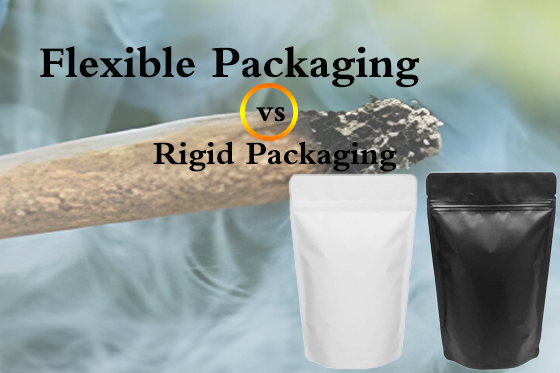Choosing between flexible and rigid packaging affects cost, sustainability, protection, shelf appeal, and fulfillment speed. This guide explains the differences, trade-offs, and a step-by-step decision framework—with examples and checklists you can use immediately.

1) Quick Definitions
Flexible Packaging
Any pack that can readily bend or conform to shape—e.g., pouches, sachets, bags, wraps, and rollstock. Often made from films, foils, or paper-based laminates; typically lighter and more material-efficient.
Rigid Packaging
Structures that retain shape under normal load—e.g., glass bottles, metal cans, rigid plastics (containers, clamshells), paperboard cartons, and corrugated boxes. Usually superior for stacking, protection, and premium shelf presence.
2) Common Materials
Flexible
-
Mono-material PE/PP films (increasingly recyclable)
-
Multi-layer laminates (PET/AL/PE for barrier)
-
Paper + bio-based coatings (compostable options exist)
-
Foil structures for high oxygen/moisture barrier
Rigid
-
Glass (chemically inert, premium look)
-
Metal (aluminum, steel; excellent barrier, retortable)
-
Rigid plastics (PET, HDPE, PP; widely used, lightweight relative to glass/metal)
-
Paperboard/corrugated (shippers, cartons, inserts)
Note: Your regulatory needs (food contact, child-resistance, tamper evidence) may restrict material choices.
3) Flexible vs. Rigid: Comparison Table
| Factor | Flexible Packaging | Rigid Packaging |
|---|---|---|
| Protection | Good with correct barrier & structure; less crush resistance. | Excellent crush & puncture resistance; great for fragile goods. |
| Weight & Logistics | Very light; ships/stores flat; low transport emissions. | Heavier/bulkier; higher freight & storage costs. |
| Cost (Unit) | Usually lower per unit; high-speed form-fill-seal-friendly. | Higher per unit; tooling & mold costs may apply. |
| MOQ & Lead Time | Lower MOQs common; fast print runs (digital/flexo). | Often higher MOQs; longer for molds or glass furnaces. |
| Branding | Large printable area; zippers/spouts for UX. | Premium feel & shape storytelling; rigid walls for labels & embossing. |
| Sustainability | Less material by weight; mono-material designs improving recyclability. | High recycling rates for glass/metal in many regions; refill/reuse potential. |
| Consumer Experience | Portable, reclosable options; can be harder to stand/stack once opened. | Stands/dispenses easily; perceived quality is higher. |
| Regulatory Options | Child-resistant/ tamper-evident available for pouches. | CR closures, tamper bands common; strong for pharma & beverages. |
4) Best-Fit Use Cases & Real Examples
Dry foods
Coffee, snacks: flexible with barrier
Liquids
Beverages, sauces: rigid bottles/cans
Fragile
Glassware, electronics: rigid + corrugated
Refill
Pouches for refill, rigid for primary
Patterns that work well
-
Premium liquids → Glass/PET bottles with tamper bands.
-
Powders & snacks → Stand-up pouches with zippers; nitrogen flush optional.
-
D2C shipping → Flexible primary + corrugated mailers/inserts.
-
Retail peg display → Hang-hole pouches reduce shelf footprint.
-
Club stores → Rigid multipacks for stackability + billboard branding.
5) Sustainability & Compliance
Practical levers: right-sizing, lightweighting, mono-materials (PE-PE or PP-PP), post-consumer recycled content where allowed, refill systems, and accurate labeling for end-of-life.
Consider regional recycling access, Extended Producer Responsibility (EPR) fees, and any claims substantiation (e.g., “recyclable” depends on local capability). For food/pharma, ensure materials meet applicable contact and migration standards and document traceability.
6) Costs, MOQs & Logistics
What typically drives cost?
-
Materials & barrier layers (foil and high-barrier films cost more)
-
Decoration method (digital for short runs; flexo/gravio for volume)
-
Tooling (molds/dies), changeovers, and line speed
-
Freight & storage (rigid occupies more volume, raising landed cost)
Tip: Evaluate total delivered cost—materials + converting + freight + storage + damage/returns—not just the unit price.
7) Design, Branding & UX
-
Opening/reclosing: zippers, sliders, tear notches (flexible); caps, pumps, CR closures (rigid).
-
Ergonomics: spouts/handles for liquids; stand-up bases for pouches.
-
Print quality: matte/soft-touch films vs. gloss varnish on rigid labels or direct print.
-
Information density: pouches offer billboard faces; rigid supports labels, sleeves, or embossing.
8) Decision Framework (5 Steps)
-
Define product risks: liquid? fragile? oxygen/light sensitive? required shelf life?
-
Map channels: D2C parcel vs. retail pallet—affects drop/stack tests and outer packs.
-
Regulatory & claims: food/pharma contact, CR, tamper evidence, recyclability claims.
-
Brand & UX goals: premium cues, dispensing, on-the-go convenience.
-
Model costs & footprint: include logistics, damage rates, and scalability (MOQs/lead time).
9) Quality & Testing Considerations
Typical tests to plan
-
Barrier (OTR/WVTR), seal strength, burst, puncture, and drop/stack testing
-
Transit simulations (e.g., vibration, compression) for D2C vs. palletized shipping
-
Migration/suitability for intended use; shelf-life studies and aging
-
Child-resistance/tamper-evidence where mandated
10) FAQs
Is flexible packaging always cheaper than rigid?
Often, but not always. While material and freight are lower, added barrier layers, custom features (zippers/spouts), and high-quality print can narrow the gap. Always compare landed cost and damage/return rates.
Which is more sustainable: flexible or rigid?
It depends on region and system design. Flexible uses less material and ships flat, reducing emissions; rigid glass/metal can have high recycling rates and enable reuse. Mono-material flexible and lightweight rigid with recycled content are both improving footprints.
When should I choose rigid over flexible?
For fragile contents, premium shelf presence, hot-fill/retort needs, or when stacking and dispensing stability are critical (e.g., beverages, cosmetics glass, pharma vials).
What are common flexible formats?
Stand-up pouches (with or without zipper), flat pouches, sachets, stick packs, and rollstock for vertical/horizontal form-fill-seal lines.
What about child-resistant (CR) options?
Both flexible (CR zipper pouches) and rigid (CR caps/closures) can meet CR requirements. Verify test certificates for your market and product category.
Can I mix formats (e.g., flexible primary + rigid secondary)?
Yes—common for D2C: flexible primary for efficiency, shipped inside rigid corrugated with inserts for protection and unboxing experience.
What print methods are best?
Short runs: digital (fast turns, variable data). Volume: flexo/gravure for cost and color depth. Rigid can use pressure-sensitive labels, shrink sleeves, screen print, or direct print.
How do MOQs differ?
Flexible often supports lower MOQs, especially with digital print; rigid (glass, injection blow) may require higher MOQs and longer lead times due to tooling and furnace schedules.
Do flexible pouches protect against oxygen and moisture?
Yes, with suitable barrier films (e.g., metallized, EVOH, foil). Match barrier to shelf life, consider reclose features, and validate with OTR/WVTR testing.
What’s the fastest path to pilot?
Start with stock rigid or digitally printed short-run pouches, run small market tests, gather feedback, then scale to volume-optimized materials and print methods.
Next Steps
Use the decision framework above to shortlist two or three candidate formats. Request samples, run quick barrier and drop tests, and model total delivered cost before locking in tooling or large MOQs.
Barrier first Right-size weight Label claims you can prove Design for recycling


